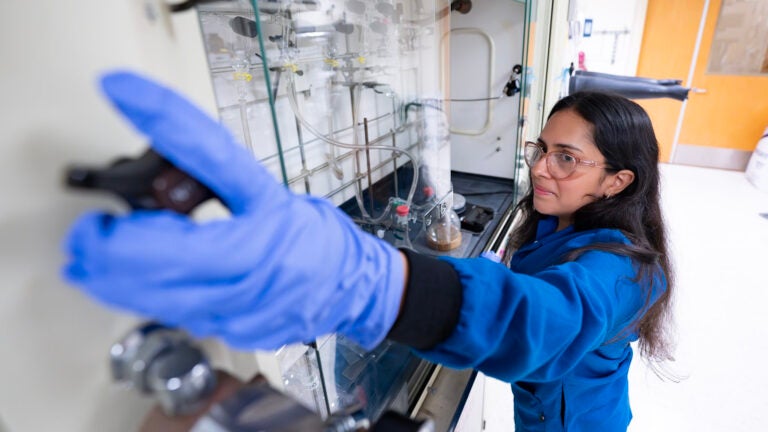
2024 Wrigley Institute Graduate Fellow Clarissa Olivar, a PhD student in the USC Dornsife Department of Chemistry, adjusts nitrogen pressure on a fume hood. (Nick Neumann/USC Wrigley Institute)
Transforming Waste into Pharmaceuticals
I remember the first time I met my dog, Hippie, with so much clarity. He was so anxious to meet his new family that all he could do was lick the air around him. This was over fifteen years ago, and I am thankful for every day since. Caring for him and my other dog, Calvin, has brought so much happiness and perspective to my life so naturally, I was very upset when I was told that Hippie might be displaying early signs of dementia.
Dementia is an umbrella term for diseases that cause a loss of cognitive function, with 55 million people currently diagnosed with dementia, and countless more pets suffering the same symptoms. The most prominent form of dementia is Alzheimer’s disease, making up 60 – 70% of all dementia cases in people worldwide. The cause of Alzheimer’s disease is still unclear; however, some researchers believe it is caused by a reaction in which Tau protein, intended to stabilize parts of your brain, instead reacts with itself (Tau protein aggregation). A possible deterrent to Alzheimer’s disease is introducing a molecule that inhibits Tau protein aggregation.

What if there is a way to contribute to finding cures to debilitating diseases while addressing an environmental challenge: the global increase in waste that contributes to air pollution and soil and water contamination?
My project addresses composite waste in lightweight rail vehicles (LRVs). Composites are materials comprising two distinctive components that together display enhanced mechanical properties when compared to their individual counterparts. Of specific interest to my project is polystyrene-containing carbon fiber reinforced polymer (CFRPs) composites, as they are found in a variety of industrial sectors such as the transportation industry. CFRPs comprise ordered carbon fiber fabric plies (layers) immobilized by a matrix, often consisting of crosslinked thermosetting polymers, in this case polystyrene.

CFRPs are an attractive alternative to traditional materials used in rail vehicles as they have comparable mechanical properties while being lightweight. The larger the mass of the vehicle, the more energy that is consumed, therefore reducing the weight of the vehicle will reduce greenhouse gas emissions. However, it is difficult to repair or recycle CFRPs, therefore, once structural defects arise, CFRPs components almost invariably end up in landfills.
Current research trends generally focus on recovering either the carbon fibers for reuse or transforming the polymer matrix. This approach neglects the value of both components. It is therefore imperative that environmentally friendly end-of-life processes be established that retain the value of both components by converting CFRPs’ polymer matrix into valuable material(s) and recovering usable carbon fiber substrates for remanufacturing.
Previously, via support from USC Wrigley Institute for Environment and Sustainability, our group was able to convert polystyrene post-consumer waste, commonly found in food packaging, into benzoic acid. This isolated benzoic acid was then utilized as a food source for genetically modified fungi. The fungi metabolize benzoic acid into asperbenzaldehyde–a molecule of pharmaceutical interest in Alzheimer’s disease research as it has been shown to inhibit Tau protein aggregation. Applying similar conditions to polystyrene containing CFRPs, we were not only able to bio-catalytically synthesize a molecule of pharmaceutical interest from transformed pre- and post-consumer composite materials but we are also able to recover the carbon fiber plies and use them to remanufacture a second-generation composite, therefore recovering value from each composite component.

My project is very close and meaningful to me as although I know it will not be able to help those currently like Hippie, it will, hopefully, have a meaningful contribution to not only disease research but encourage others to consider end-of-life processes for sustainable infrastructure.
This project is in collaboration among USC Alfred E. Mann School of Pharmacy and Pharmaceutical Sciences, USC Viterbi School of Engineering, and the University of Kansas Department of Molecular Biosciences. I am thankful for the USC Wrigley Institute for Environment and Sustainability’s financial support in continuing this project, the amazing principal investigators who provide invaluable advice and mentorship: Professor Travis J. Williams, Professor Clay C. C. Wang, Professor Steven R. Nutt, and Professor Berl R. Oakley, and my partners on this project: Ben Miller, Maria Tangalos, Zehan Yu, and Y. Justin Lim-we make a great team!
Clarissa Olivar is supported by the Diane Sonosky Montgomery and Jerol Sonosky Graduate Fellowship for Environmental Sustainability Research.